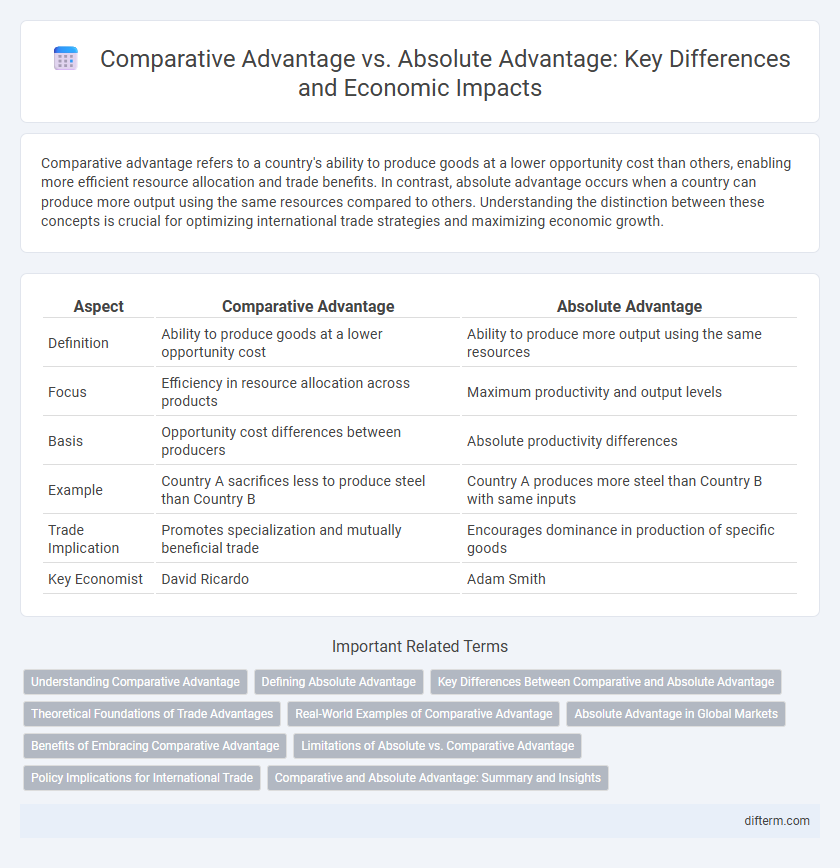Comparative advantage refers to a country's ability to produce goods at a lower opportunity cost than others, enabling more efficient resource allocation and trade benefits. In contrast, absolute advantage occurs when a country can produce more output using the same resources compared to others. Understanding the distinction between these concepts is crucial for optimizing international trade strategies and maximizing economic growth.
Table of Comparison
| Aspect | Comparative Advantage | Absolute Advantage |
|---|---|---|
| Definition | Ability to produce goods at a lower opportunity cost | Ability to produce more output using the same resources |
| Focus | Efficiency in resource allocation across products | Maximum productivity and output levels |
| Basis | Opportunity cost differences between producers | Absolute productivity differences |
| Example | Country A sacrifices less to produce steel than Country B | Country A produces more steel than Country B with same inputs |
| Trade Implication | Promotes specialization and mutually beneficial trade | Encourages dominance in production of specific goods |
| Key Economist | David Ricardo | Adam Smith |
Understanding Comparative Advantage
Understanding comparative advantage involves recognizing that it drives international trade by allowing countries to specialize in producing goods with the lowest opportunity cost, leading to increased overall efficiency. Unlike absolute advantage, which compares productivity levels, comparative advantage emphasizes relative efficiency and opportunity cost differences between nations. This concept explains why countries benefit from trade even when one can produce all goods more efficiently, promoting global economic growth.
Defining Absolute Advantage
Absolute advantage occurs when a country or individual can produce a good or service more efficiently than others using fewer resources or less time. This concept emphasizes the ability to generate higher output with the same input, leading to cost savings and increased productivity. Understanding absolute advantage helps explain international trade patterns by highlighting who can produce what most efficiently.
Key Differences Between Comparative and Absolute Advantage
Comparative advantage occurs when a country produces goods at a lower opportunity cost, enabling more efficient trade specialization, while absolute advantage refers to a country's ability to produce more output using the same resources. The key difference lies in opportunity cost analysis for comparative advantage versus sheer productivity for absolute advantage. Understanding these concepts helps optimize international trade strategies and resource allocation.
Theoretical Foundations of Trade Advantages
Comparative advantage occurs when a country specializes in producing goods with the lowest opportunity cost, enabling more efficient resource allocation and mutual gains from trade. Absolute advantage refers to the ability of a country to produce a good using fewer resources than another. The theory of comparative advantage, developed by David Ricardo, underpins modern trade theory by demonstrating that even if a nation lacks an absolute advantage, it can still benefit from trade by focusing on relative productivity differences.
Real-World Examples of Comparative Advantage
Comparative advantage explains how countries benefit by specializing in producing goods with the lowest opportunity cost, such as Vietnam exporting textiles despite lower productivity than China. This principle drives global trade patterns, illustrated by India focusing on software services due to its skilled labor force, while the U.S. leads in high-technology manufacturing. Real-world comparative advantage promotes economic efficiency and higher overall output by encouraging countries to trade rather than attempt self-sufficiency.
Absolute Advantage in Global Markets
Absolute advantage in global markets occurs when a country produces a good more efficiently than any other nation, using fewer resources or less time. This efficiency boosts export potential and strengthens trade balances by enabling the country to dominate specific industries. Countries with absolute advantages often attract foreign investment and increase economic growth through specialization and scale economies.
Benefits of Embracing Comparative Advantage
Embracing comparative advantage allows countries to specialize in producing goods where they have the lowest opportunity cost, maximizing overall economic efficiency and global output. This specialization fosters increased trade, leading to expanded markets, higher productivity, and enhanced consumer choice. Unlike absolute advantage, which is based on overall productivity, comparative advantage drives mutually beneficial exchanges even when one country is less efficient in producing all goods.
Limitations of Absolute vs. Comparative Advantage
Absolute advantage focuses on producing goods more efficiently than others, but it overlooks opportunity costs, limiting its effectiveness in explaining resource allocation. Comparative advantage emphasizes lower opportunity costs, providing a more practical framework for trade decisions, yet it assumes perfect mobility of factors and constant returns to scale, which rarely hold in real economies. Both concepts fail to fully capture complexities such as economies of scale, technological change, and differing factor endowments that influence international trade dynamics.
Policy Implications for International Trade
Comparative advantage emphasizes that countries benefit from specializing in goods where they have lower opportunity costs, guiding policymakers to promote trade liberalization and targeted industry support for maximizing economic efficiency. Absolute advantage highlights the role of productivity differences, encouraging policies that invest in technology and infrastructure to boost overall production capacity. Effective international trade policies balance these concepts by fostering competitive specialization while enhancing domestic capabilities to strengthen global trade positions.
Comparative and Absolute Advantage: Summary and Insights
Comparative advantage occurs when a country produces goods at a lower opportunity cost than others, enabling more efficient resource allocation and mutual gains from trade. Absolute advantage refers to a country's ability to produce a good using fewer resources or more efficiently than another country. Understanding the distinction between these concepts clarifies that trade benefits arise primarily from comparative advantage, even if one nation holds absolute advantage in all products.
Comparative advantage vs Absolute advantage Infographic

 difterm.com
difterm.com